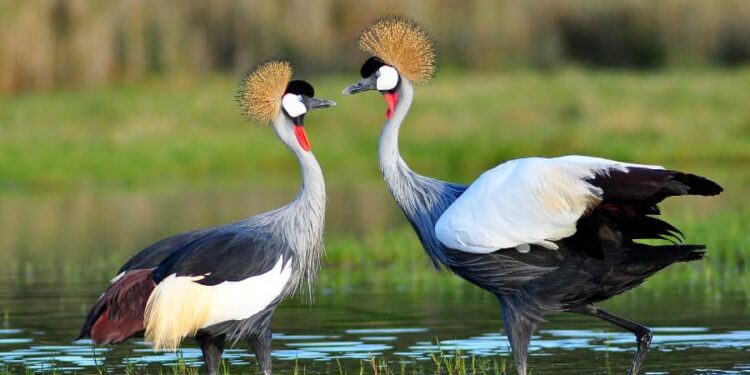The encroachment of wetlands by farmers and the high market demand for the sale of grey crested cranes have triggered a worrying decline in the population of the national bird, raising concerns among environmentalists and conservationists in the Kigezi sub-region of Uganda. This decline is largely attributed to the loss of their natural habitat as wetlands are converted for various farming activities.
Henry Mtifundinda, the program manager of Nature Uganda, emphasized the adverse impact of wetland encroachment on crested cranes. As wetlands shrink, these magnificent birds are compelled to venture into farmlands in search of food, putting their lives at risk. Tragically, they often fall victim to poisoning, and their chicks and eggs are stolen, further compromising their population. In 1980, the Kigezi sub-region boasted a population of over 100,000 crested cranes, but today, that number has dwindled to a mere 10,000 to 20,000. This alarming decline has the conservation community deeply concerned.
Mfitundinda also highlights the illegal poaching of crested cranes for witchcraft and traditional purposes, a practice that exacerbates the challenges facing this already endangered species. He calls for stringent government measures to restore wetlands and protect the crested cranes.
Jane Amumpire, the Natural Resources officer in Rubanda district, provides insight into the extent of wetland encroachment, estimating it to be at a staggering 97%, with only 3% remaining unaltered. The root causes of this encroachment include a growing population and the degradation of catchment areas. The high demand for food drives farmers to cultivate in wetlands, leaving crested cranes with diminishing places to call home. This loss of habitat poses a severe threat to their existence.
Amumpire emphasizes that crested cranes are increasingly marginalized due to farming activities, making it difficult for them to find suitable resting places. She underscores the urgent need to address this issue before the bird’s population is further depleted.
Henry Tumwesigye, the Natural Resources officer of Kabale district, adds that wetlands serve as crucial habitats for crested cranes, acting as breeding grounds where they lay their eggs. The loss of 60% of wetlands to human activities, such as crop production and bricklaying, directly impacts the survival of these birds. Tumwesigye expresses hope that the presidential directive will assist in their conservation efforts.
Tumwesigye also emphasizes the need for enforcement of the presidential directive, ensuring the evacuation of those who have encroached on wetlands. He believes that enforcing laws will play a pivotal role in preserving the remaining wetlands.
In a recent address, the President of Uganda emphasized the importance of action, directing the Regional District Commissioners (RDC) and parish chiefs to take immediate measures against those who have encroached on wetlands.
The crested crane, chosen as the national bird of Uganda in the 1980s, represents the country’s natural beauty. However, its future is at risk due to the encroachment on its natural habitat. Conservationists and government officials are now working together to safeguard these iconic birds and restore the wetlands that are essential to their survival.
Do you have a story in your community or an opinion to share with us: Email us at editorial@watchdoguganda.com










